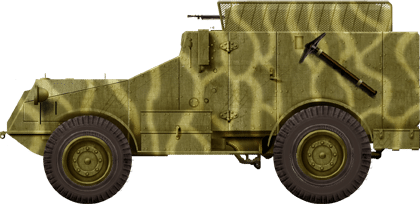The French colonial APC
From the start of the Second World War, APCs, or armored personnel carriers, were mass-produced by the US (M3 half-track) and Germany (Sd.Kfz.251). However, other countries completely overlooked this class of vehicles. Commonwealth troops improvised the "Kangaroo" series using turret-less tanks and disarmed SPGs. These were used especially in Normandy and the subsequent fight until 1945. The Soviets used their tanks to carry their troops into battle, hanging onto bars welded on the T-34's turret. They also used small tractors, like the Komsomolets, as well as Lend-Lease half-tracks received from the US. The Italians also improvised a small number of models during the war, such as the Dovunque 35 Blindato, the FIAT 655NM Protetto and the Autoprotetta S.37. They were all partially armored, with an open roof, and only built in small numbers. In France, General Estienne thought that the Schneider tank could carry troops up to the enemy trenches during the First World War. However, the tank was too cramped, hot and noisy for such an operation to ever be put into practice.In the 1930s, during the Rif War in Morocco, significant quantities of French troops were drawn in. The conflict was also used for experiments with combined armored columns and aviation. The Army asked for the development of a troop carrier able to rapidly transport infantry units to the front of a column when the highly mobile and evasive rebel troops were spotted. To simplify maintenance and lower costs, Panhard proposed an adaptation of their model 175 chassis.
The Model 165 CPB was developed in 1934 at the request of the army for the TOE (Théâtres d'Opérations Extérieurs, Foreign Operation Theaters), in competition with other models. Only this one and the Berliet VUDB were approved and produced for service in limited quantities. It should be noted that the French also produced a fully tracked APC in 1940, the VBCP (voiture blindée de chasseurs portés) Lorraine 38L, based on the standard 37L tractor.
Design
The Panhard 165 CBP shared its mechanical elements with the Panhard 165. The rear part was completely rebuilt, with a cabin large enough for 6 equipped soldiers, in addition to the vehicle commander and the driver. It was a simple rectangular riveted box, with mudguards cut into the lower part and supports for tools and utility boxes behind each wheel. Access to the combat compartment was through the rear, with two doors opening to the sides. The ten soldiers were seated on back-to-back benches facing each wall.Above the main armored box was a sloped roof with hatches on top for ventilation. There was an opening at the front of this structure for the machine gun and a single slit at the rear. The main compartment had an armored vision slit on each side and two more at the rear. Front visibility was restricted to two small armored panels for the driver and commander that could be raised up to give a better field of view. The panel on the right also had a vision slit to allow some visibility when buttoned up. Additional armored windows were placed on each side of the driver's compartment.
The only weapon onboard was a MAC 31 or FM 24/29 7.5 mm machine gun placed on the right of the top structure. The gunner had to stand to operate it. Traverse was limited by the small vertical opening. Armor
The lower hull front was protected by 9 mm thick armor plate, with thinner 7 mm plates for the upper hull front, sides and rear. The top superstructure only protected by 5 mm armored plates, like the top of the bonnet. The hull bottom was only 4 mm thick, offering little protection.
Mobility:The chassis and mechanical parts were taken from the Panhard 175, so a gasoline engine Panhard 4-cylinder engine delivering 90 hp. Offroad capabilities were limited, but sufficient for the North African landscape. Ground clearance was 0.31 m, maximum fording depth 0.60 m, trench crossing 0.70 m, obstacle clearance 0.30 m and climbing ability 40°.
Production: It is difficult to establish how many were produced. Some sources states 30 vehicles built, other 20, Panhard's own records 12 vehicles. It is possible some were later conversions.
Panhard 165 CBP specifications |
|
| Dimensions | 5.43 x 2.10 x 2.20 m |
| Total weight, battle ready | 7 metric tonnes |
| Crew | 2+6 (driver, commander/gunner, 6 infantry) |
| Propulsion | Panhard 4-cyl SK gasoline, 105 hp, 4 Forward & 1 Reverse transmission |
| Speed | 70 km/h (45 mph) |
| Suspensions | 4 x 4 leaf spring suspensions |
| Range/fuel capacity | 600 km (350 mi)/200 l |
| Armament | MAC M1931 7.5 mm (0.295 in) machine-gun |
| Armor (max) | 5 to 9 mm (0.33 in) |
| Total production | Circa 20 |
The Panhard 165 CBP in action

Panhard 165 CBP, 3rd BCA (Bataillon de Chasseurs d’Afrique) 1940.
Most the the vehicles were Sent to serve with the 1st REC, then in June 1940, the 1st RCA operating in Morocco.
Sources
https://www.quartermastersection.com/french/afvs/609/Panhard179Model on scalemate
Model on Blitz
"Les chasseurs d'Afrique" Histoire&collection
Magazine Histoire de Guerre Blindés et Matériel N°78
Militaria magazine n°42 (art sur le REC)
https://fr.wikipedia.org/wiki/Lorraine_38L
https://www.ouarzazate-1928-1956.fr/armee/artillerie/297-les-vehicules-blindes.html
https://www.tapatalk.com/groups/missinglynx/panhard-165-175toe-et-camion-blinde-179-t295967.html
https://minitracks.1fr1.net/t2092p25-camion-blinde-panhard-179-1-72-eme-scratch

WW2 Tanks




























WW2 tanks posters

All Tiger tanks liveries.

Panther liveries and variants

WW2 Armour - All tanks











Tanks aces and single tanks series

Find more there

Museums, Movies, Books & Games
The Tanks and Armor in pop culture
Tanks and armored vehicles in general are only really grasped when seen first person: The mass, the scale, it's all there. Explore also the way tanks were covered in the movie industry, in books and in video games.Movies:
Best tanks movie on warhistoryonline.com
On imdb.com
On bestsimilar.com/
miltours.com
liveabout.com/
watchmojo.com
Video Games:
pcgamesn.com
historyhit.com
levvvel.com
vg247.com/best-tank-games
mmobomb.com/
alienwarearena.com

